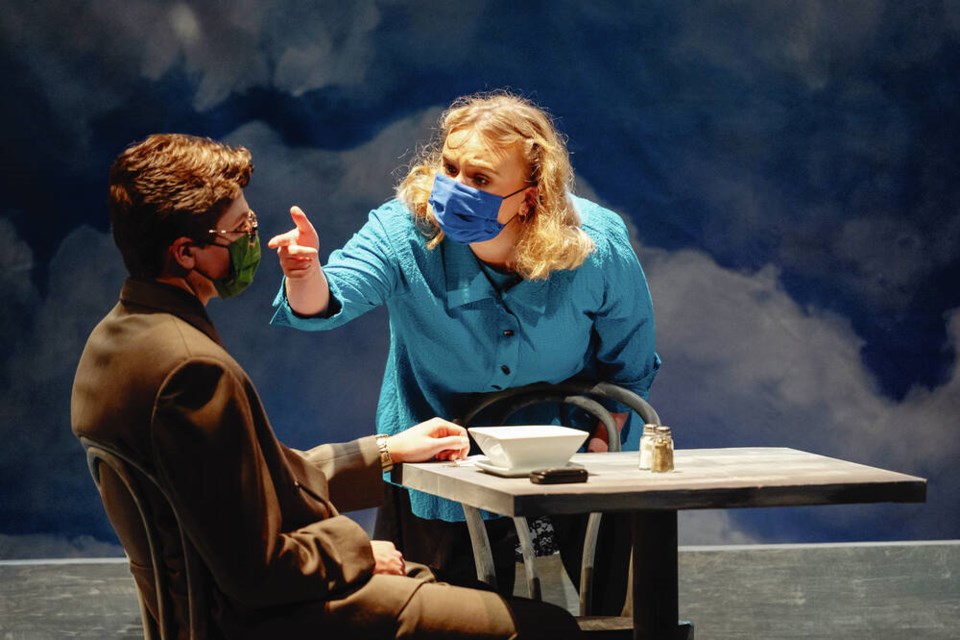ON STAGE
What: Dead Man’s Cell Phone
Where: Phoenix Theatre, 3800 Finnerty Rd., University of Victoria
When: Through Nov. 27 (streaming performances Nov. 19-27)
Tickets: $15-$30 from finearts.uvic.ca or 250-721-8000
Mobile phones were merely devices when American playwright Sarah Ruhl penned Dead Man’s Cell Phone in 2007. A decade-and-a-half and several digital revolutions later, the inter-connected world of mobile technology is much more murky.
Cell phones — now sold as smartphones — are akin to appendages today. Big Tech markets these electronic exoskeletons as being intuitive, but they are nothing if not invasive. How that impacts interpersonal communication and humankind in general made for some interesting analyses leading up to the Phoenix Theatre’s production of the Off-Broadway hit.
“When Sarah Ruhl wrote the play, it resonated very strongly throughout the theatrical community,” said Fran Gebhard, who is directing. “But with the overshadowing of COVID-19, the play resonates even more loudly today. Because of the loneliness, and isolation, even though as humans we are meant to be connected, technology gives us a false sense of connection. That is even more true now. We yearn as human being to be together in person.”
Gebhard set Dead Man’s Cell Phone in the early 2000s, with a flip phone as the device of choice. That gave the story about the unifying and isolating effects modern technology has on society both a pre- and post-modern vibe, according to Gebhard. “We have two time periods, the one in which the play is written, and today.”
Set and lighting designer Patrick Du Wors upgraded to his first smartphone in 2008, not long after the original production of Dead Man’s Cell Phone premiered and the world’s first iPhone arrived. “That completely transformed my relationship to a cell phone,” he said. He remembers the shift moreso than many of the students in the university’s theatre program, most of whom are in their early 20s and have grown up amid the digital monoculture.
“One of the things that exists in this play is people talking on their cell phones, as opposed to texting or messaging,” Du Wors said. “With Airpods and other Bluetooth headphones, we are seeing people again talking on their phones a lot more than we have for the last 10 years or so.”
Du Wors, an assistant professor at the school’s department of theatre, was an invaluable resource leading up to the Phoenix Theatre’s first mainstage production since March 2020. He was set and lighting designer for a run of Dead Man’s Cell Phone performances nine years ago at Saksatoon’s Persephone Theatre. He used his script notes and lighting cues from that production for the upcoming run.
“I was really excited about being able to revisit this design,” he said. “That production was in a studio space, which has less resources. The fact we were able to put this on the [main] stage meant that things I weren’t completely able to achieve in the original production we can try to achieve here.”
Though it hinges upon technology, Dead Man’s Cell Phone looks loving at the analogue world, Du Wors said. “On one hand, Ruhl is writing a love letter to paper. What she was trying to do with this play is talk about how these digital fragments, whether that is audio or text, are lost in the ether. They vanish. It’s not like a love letter or a note.”
The Phoenix Theatre production features a dance segment which uses a soundscape of conversations by sound designer Miriam Dumitra to exppound upon that digital-analogue analogy. “The idea is that these things are still around, that human-connection energy doesn’t always have to happen on paper. It continues, even though it vanishes.”



